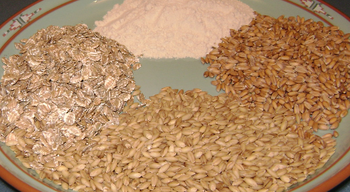 |
| English: Heston Blumenthal at Taste Of London Festival, June 2010 (Photo credit: Wikipedia) |
-----
BY SOPHIE BRICKMAN
How do you make ground-up crickets taste good?
The answer may be just a sprinkling of ginger and ras el hanout, a North African spice blend. And there’s chocolate.
Greg Sewitz, 22, and Gabi Lewis, 23, began making protein bars out of crickets when they were roommates at Brown University in Rhode Island. Mr. Lewis, a philosophy major who tried to follow a paleo diet (eating what our cave-man ancestor presumably ate and minimizing his sugary foods), couldn’t find a bar that fit his needs. “They were all like candy,” he said.
When Mr. Sewitz, a cognitive neuroscience major, attended a conference at which one of the speakers discussed insects as a sustainable food source, an idea was born.
According to the two men’s research, the insects are 69 percent protein by dry weight as compared with 31 percent for chicken breast and 29 percent for sirloin steak; they provide more iron than beef does and nearly as much calcium as milk. They produce one-eightieth the amount of methane that cattle do, and need one-twelfth their feed.
The roommates overcame the ick factor by freezing the crickets, roasting them and putting them in a blender. “There were cricket parts all over the place, and our roommates got a little weirded out,” Mr. Sewitz said.
Their reward was their first batch of cricket flour, a dusty brown substance that resembled brown sugar and didn’t taste like much. They combined it with almonds, dates for binding, honey for sweetness and raw cacao nibs for crunch.
After graduating in May 2013, the men, having by then moved to New York, decided to start a business called Exo (for exoskeleton). They turned to Kickstarter, to raise $20,000 in a month. They hit their goal in three days.
They then had to figure out how to make the snacks palatable to a wide audience. A mutual friend introduced them to Kyle Connaughton, 37, the former head of research and development for the Fat Duck in Bray, England, one of the most acclaimed restaurants in the world, known for pushing the culinary envelope. Mr. Connaughton and Heston Blumenthal, The Fat Duck’s owner, had once created a dish of fried mealworms and crickets injected with a mix of mayonnaise and onion gel.
Mr. Connaughton developed recipes that made sure each bar contained 10 grams of protein, the equivalent of about 40 crickets. Along with the original cacao nut flavor, the first line features peanut butter and jelly, and cashew ginger.
The two partners plan to sell the bars in natural-food stores and CrossFit-type gyms – places that attract the growing number of paleo lifestyle enthusiasts.
“At the end of the day, it’s a protein bar,” Mr.Sewitz said. “If it’s sustainable, that’s great, but it’s going in your body and you want to know that it’s good for you and tastes delicious.”
Taken from TODAY Saturday Edition, March 8, 2014
----------
Would you starve yourself to be healthier?


















